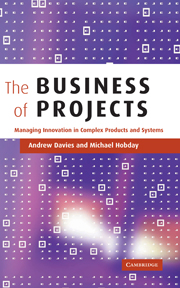Book contents
- Frontmatter
- Contents
- List of figures
- List of tables
- Foreword
- Acknowledgements
- Glossary
- 1 Introduction
- 2 The dynamics of innovation in complex products and systems
- 3 Business strategy and project capability
- 4 Systems integration and competitive advantage
- 5 The project-based organisation
- 6 Managing software-intensive projects
- 7 Learning in the project business
- 8 Integrated solutions for customers
- 9 Lessons for the project business
- Appendix A
- Appendix B
- Appendix C
- References
- Index
Appendix A
Published online by Cambridge University Press: 22 September 2009
- Frontmatter
- Contents
- List of figures
- List of tables
- Foreword
- Acknowledgements
- Glossary
- 1 Introduction
- 2 The dynamics of innovation in complex products and systems
- 3 Business strategy and project capability
- 4 Systems integration and competitive advantage
- 5 The project-based organisation
- 6 Managing software-intensive projects
- 7 Learning in the project business
- 8 Integrated solutions for customers
- 9 Lessons for the project business
- Appendix A
- Appendix B
- Appendix C
- References
- Index
Summary
Project-based organisation: case objectives, method and limitations
The purpose of the case study in Chapter 5 is to examine the nature, strengths and weaknesses of the PBO in comparison with the functional form through the lens of two major projects carried out within a single firm: one in a PBO division and one in a functional division. The case is a study of a firm that produces a wide range of advanced, high-cost scientific, industrial and medical equipment. The senior management in the firm wished to learn from the operating experiences of PBD, which had been in pure PBO form for around two years. PBD had proved highly successful in meeting customer needs and project performance targets. A key strategic decision was whether or not to implement a pure PBO in FMD, a larger division. The management felt that there were lessons to learn from the good and bad experiences of both organisations. Although both PBD and FMD produced similar CoPS equipment, for geographical reasons the physical merging of the two sites was not an option in the foreseeable future.
The research method involved examining the experience of two similar, complex projects (termed project P in PBD and project F in FMD) in order to review and compare project processes, problems and performance and to draw lessons for both organisations. One of the problems of case study research of this kind is the counterfactual difficulty of knowing what would have happened (e.g. in terms of performance) if another organisational structure had been applied.
- Type
- Chapter
- Information
- The Business of ProjectsManaging Innovation in Complex Products and Systems, pp. 271 - 273Publisher: Cambridge University PressPrint publication year: 2005

